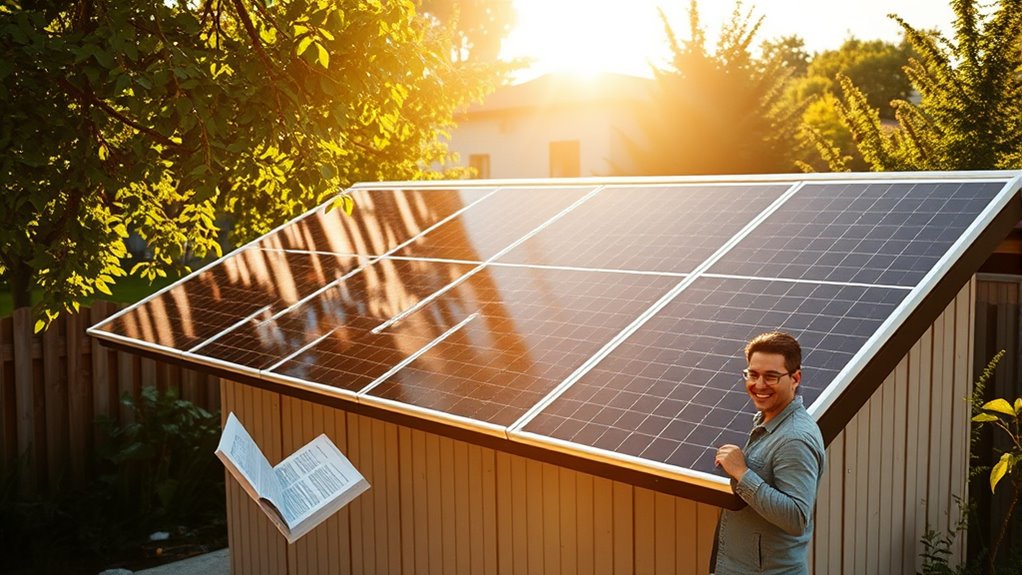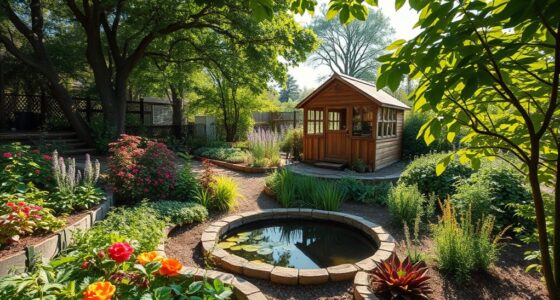DIY solar panel kits are seeing a surge in home installations due to significant cost savings and environmental benefits. By opting for a DIY kit, you could save between $7,250 and $9,759, as you avoid labor fees. Solar energy reduces harmful pollutants and conserves water, making it a smart choice for both your wallet and the planet. Plus, customizing your installation adds to the appeal. There’s much more to discover about the advantages and challenges of these kits.
Key Takeaways
- DIY solar kits offer substantial savings, reducing costs by $7,250 to $9,759 compared to professional installations.
- Homeowners gain complete control over their solar projects, allowing for customization and flexibility in installation.
- The environmental benefits of solar energy include reduced air pollutants and significant cuts in greenhouse gas emissions.
- DIY projects enhance technical skills and promote environmental responsibility among homeowners.
- Despite challenges, the growing interest in DIY solar reflects a desire for cost-effective and sustainable energy solutions.
Cost Savings of DIY Solar Kits
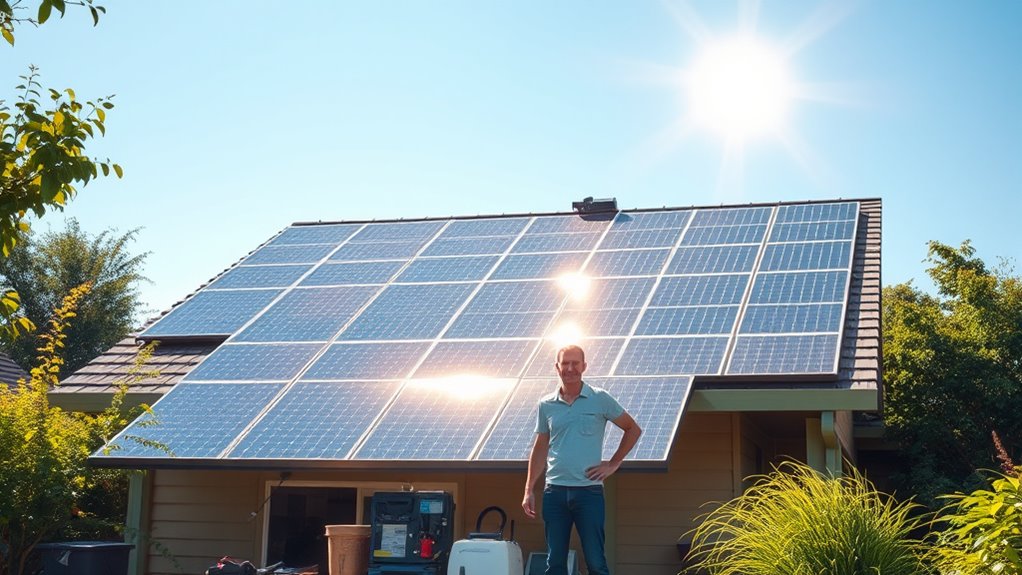
When considering solar energy, many homeowners discover that DIY solar kits can lead to significant cost savings.
By opting for a DIY approach, you can save between $7,250 and $9,759 for a typical 5 kW system, as DIY kits cost only $1.00 to $1.50 per watt compared to $2.95 to $3.25 for professional installations.
You’ll primarily save on labor and overhead costs, which account for about 27% of total expenses. Additionally, sourcing materials at wholesale prices or using second-hand equipment can maximize your savings.
While DIY projects do incur permitting costs and require technical skills, the upfront savings can be substantial, making it an appealing option for many budget-conscious homeowners seeking solar energy solutions.
Environmental Benefits of Solar Energy
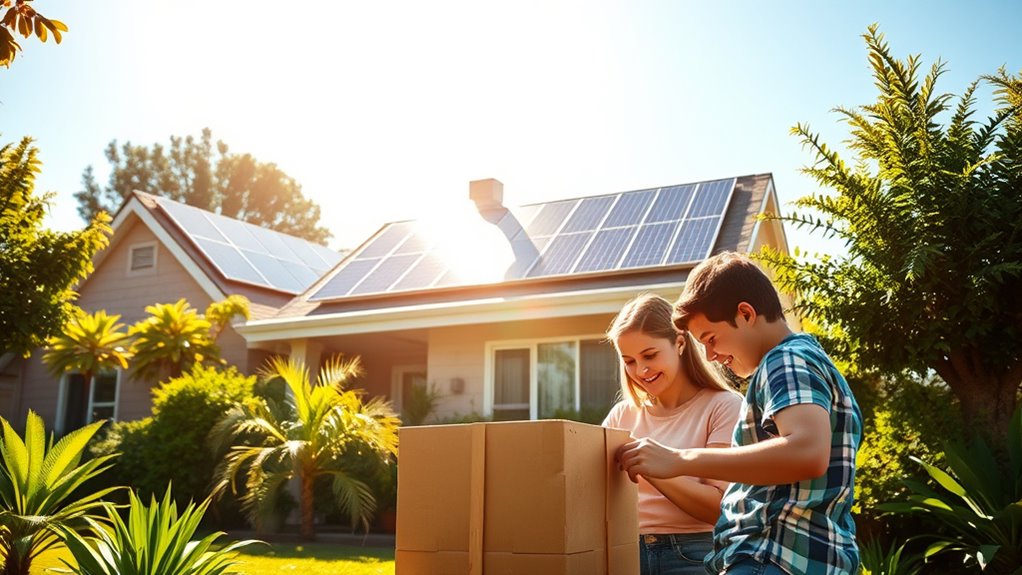
Choosing DIY solar panel kits not only saves you money but also contributes tremendously to environmental health.
By harnessing solar energy, you help reduce harmful air pollutants like nitrogen oxides and sulfur dioxides that fossil fuels emit. Solar panels generate electricity without releasing carbon dioxide or other greenhouse gases, making your energy source cleaner.
This shift can considerably cut down on climate damage and improve air quality, potentially saving trillions in health-related costs. Plus, solar systems require minimal water, conserving this precious resource compared to traditional power plants.
Key Components of DIY Solar Kits
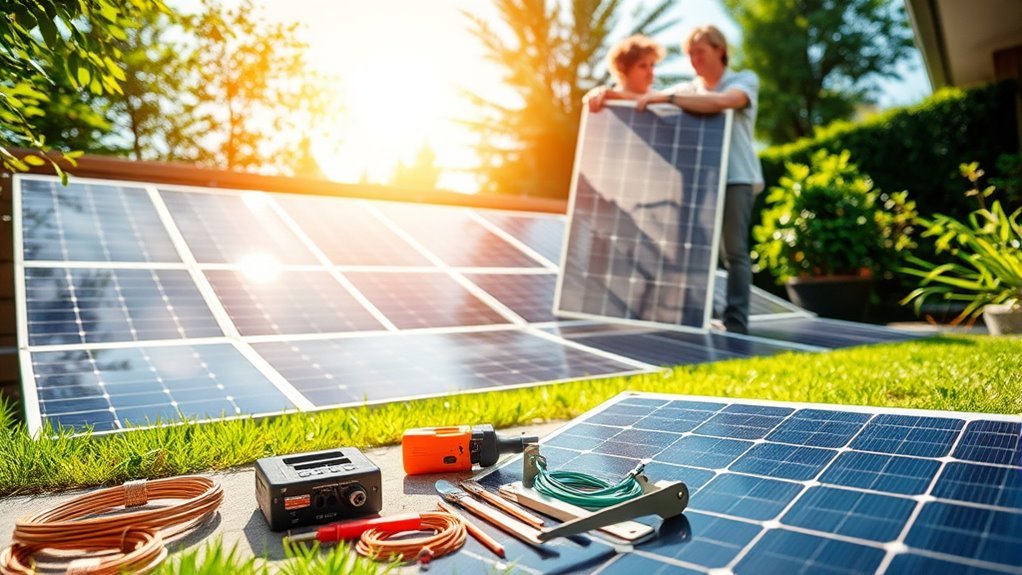
Understanding the key components of DIY solar kits is crucial for anyone looking to harness solar energy effectively.
First, you’ll need solar panel assemblies, which include solar cells, blocking diodes, soldering tools, wiring, and protective casings.
Next, inverter systems convert the DC power generated into usable AC power, with options like grid-tie or micro inverters.
Inverter systems play a vital role by converting DC power into usable AC power, with choices like grid-tie or micro inverters.
Don’t forget mounting and racking components to secure your panels, whether on the ground or your roof.
Electrical and safety components, such as disconnect switches and surge arrestors, guarantee safe operation.
Finally, consider energy storage options like charge controllers and deep cycle batteries for backup energy. Additionally, understanding energy efficiency ratings can help you optimize your solar setup for maximum performance.
With these components, you’re well on your way to creating an efficient solar setup.
Advantages of Choosing DIY Solar Installations

With all the key components in place, you can appreciate the numerous advantages of opting for DIY solar installations.
First off, you’ll save considerably on upfront costs, avoiding hefty labor fees and installation charges. This cost-effective approach not only cuts initial expenses but also reduces your long-term energy bills.
Plus, you gain complete control over the installation process, allowing you to customize the system to fit your home’s needs perfectly. You can manage the schedule at your convenience, making adjustments as necessary without relying on third-party services.
Furthermore, engaging in this hands-on project enhances your technical skills and promotes environmental responsibility, contributing to a sustainable future. Additionally, adopting solar energy solutions can lead to substantial energy bill reductions, helping you save even more over time.
Embrace the independence and satisfaction that comes with DIY solar installations!
Challenges Faced in DIY Solar Projects
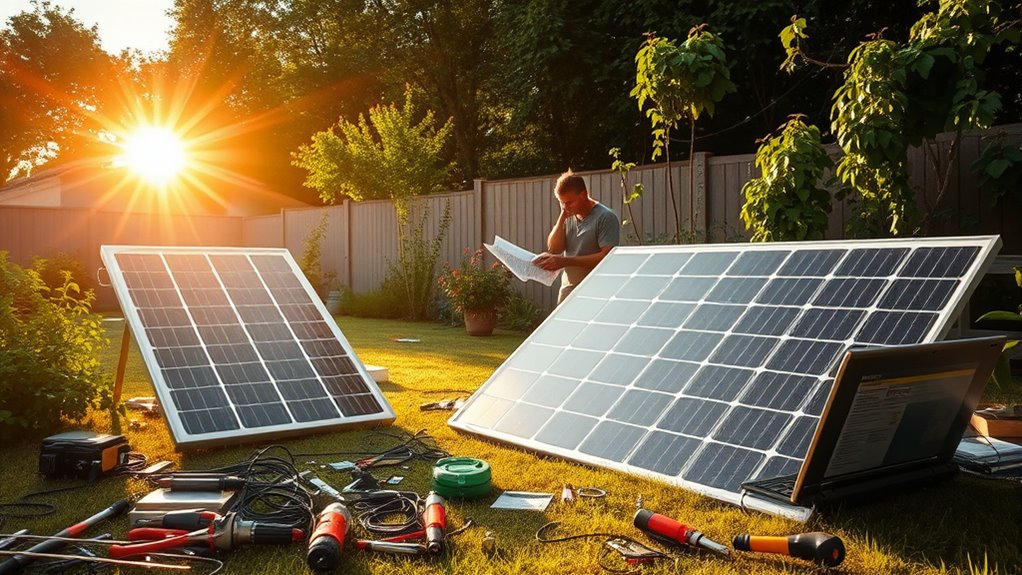
While the allure of DIY solar projects can be strong, several challenges can quickly turn the experience into an intimidating task.
You’ll face high costs for specialized equipment and the risk of choosing low-quality components due to inexperience. Without the right technical knowledge, maneuvering through electrical and roofing systems becomes overwhelming.
Safety risks, like electrical hazards and structural damage, loom large if you skip proper protocols. Additionally, the permitting process can be complex, potentially disqualifying you from government incentives and leading to compliance issues.
Neglecting safety protocols can lead to serious electrical hazards and costly compliance issues, jeopardizing your DIY solar project.
As you invest your time and effort, remember that mastering these skills is essential; otherwise, your system’s performance and lifespan could suffer, adding to your stress and frustration.
Current Market Trends for DIY Solar Kits
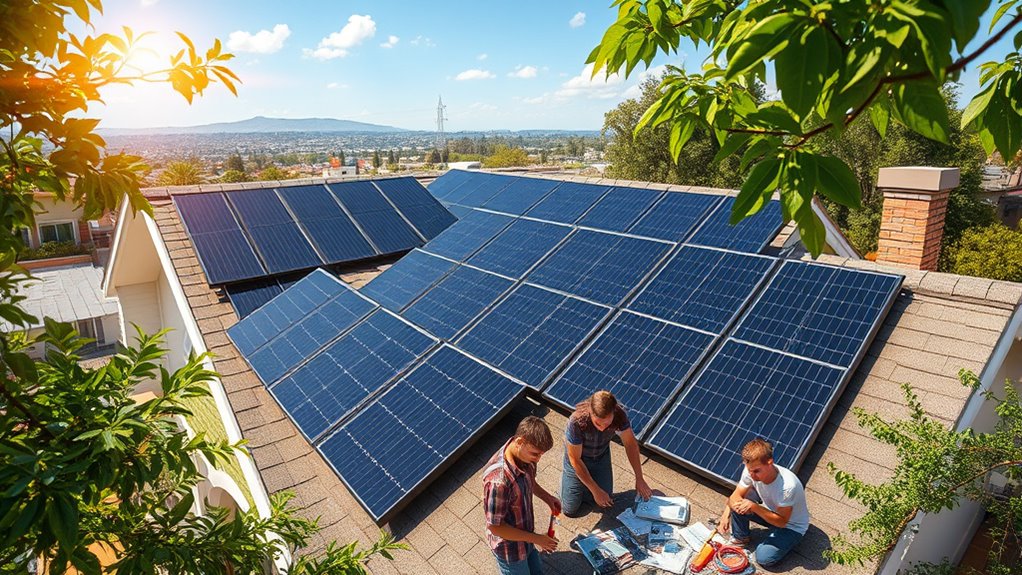
As the demand for renewable energy sources surges, DIY solar kits are gaining traction among homeowners seeking both financial savings and environmental benefits.
More people are opting for these kits due to their cost-effectiveness and the ease of installation. Technological advancements, like high-efficiency solar panels and integrated systems, enhance their appeal, allowing you to produce more energy with less space.
You’ll appreciate the control and customization these kits offer, catering to your specific needs. Extensive packages, such as those from WindyNation, simplify the process by including all necessary components.
Plus, local incentives and favorable regulations further encourage you to invest in DIY solar solutions, making this an ideal time to embrace solar energy at home.
Future Outlook for DIY Solar Installations

The future of DIY solar installations looks promising, driven by a growing desire for renewable energy and the need for cost-effective solutions.
As electricity costs rise and solar panel prices fall, you’ll find more homeowners considering DIY options. Federal incentives, like the Investment Tax Credit, make these installations even more appealing.
With advancements in smart technology and energy storage, DIY systems are becoming more efficient and user-friendly. However, you’ll need to navigate local regulations, permits, and safety standards to guarantee compliance.
As the market evolves, expect better materials and designs that enhance performance. Your ability to save money while contributing to sustainability will only grow, making DIY solar installations an increasingly viable choice. Additionally, the AI capabilities in optimizing energy usage will further enhance the efficiency of these systems.
Frequently Asked Questions
How Long Does DIY Solar Installation Typically Take to Complete?
A DIY solar installation typically takes about 2-3 days to complete for a small system, like a 3.5 kW setup.
Your installation time can vary based on project size, weather conditions, and your skill level.
If you’re facing technical challenges or need specific mounting components, it could take longer.
Always verify you’ve got the right tools and understand local regulations, as these factors can also influence the overall timeline.
Can I Install Solar Panels on a Rental Property?
You can’t install solar panels on a rental property without your landlord’s permission, since it’s a significant property upgrade.
However, you can negotiate with your landlord for shared costs or rent discounts in exchange for the installation.
If that isn’t possible, consider portable solar solutions or community solar farms as alternatives.
These options let you access renewable energy without needing to permanently alter the property.
Always discuss your plans with your landlord first.
What Tools Are Needed for a DIY Solar Installation?
For a DIY solar installation, you’ll need essential hand tools like a tape measure, level, hammer, and a socket set.
Don’t forget safety gear like a harness, hard hat, and safety glasses to protect yourself while working.
Power tools like a drill, saw, and caulk gun will make the job easier.
Finally, specialized tools like a stud finder and module mover can help secure and position your solar panels effectively.
How Do I Find Reliable DIY Solar Kit Suppliers?
Finding reliable DIY solar kit suppliers can feel like searching for a needle in a haystack, but it doesn’t have to be!
Start by researching customer reviews and ratings on trusted websites. Look for suppliers that offer robust warranties, thorough installation guides, and responsive customer support.
You’ll want options that cater to your specific energy needs. Trustworthy suppliers like GoGreenSolar and Fire Mountain Solar could be your golden ticket to a successful solar project!
Are There Tax Credits Available for DIY Solar Projects?
Yes, there are tax credits available for DIY solar projects.
If you purchase and install your solar system, you can qualify for a federal tax credit that covers 30% of your total costs.
Just remember, this credit is non-refundable, meaning it reduces your tax liability but won’t give you any cash back.
You’ll need to complete IRS Form 5695 and report it on your Form 1040 to claim the credit.
Conclusion
To sum up, diving into DIY solar panel kits not only saves you money but also contributes to a greener planet. You might worry about the complexity of installation, but these kits come with clear instructions and support, making the process manageable. Plus, the satisfaction of creating your own energy source is unbeatable. As more homeowners embrace this trend, you’re joining a community that’s making a real difference—both for your wallet and the environment.

